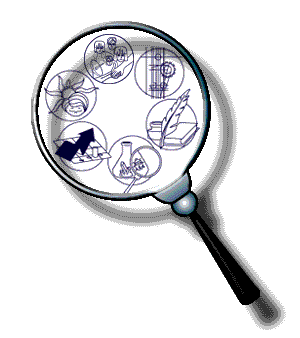
 |
7 definitions found
From The Collaborative International Dictionary of English v.0.48 [gcide]:
Notopodium \No`to*po"di*um\, n.; pl. L. {Notopodia}, {E}.
{Notopodiums}. [NL., fr. Gr. nw^ton the back + poy`s, podo`s,
the foot.] (Zool.)
The dorsal lobe or branch of a parapodium. See {Parapodium}.
[1913 Webster]
From The Collaborative International Dictionary of English v.0.48 [gcide]:
Medium \Me"di*um\, n.; pl. L. {Media}, {E}. {Mediums}. [L.
medium the middle, fr. medius middle. See {Mid}, and cf.
{Medius}.]
1. That which lies in the middle, or between other things;
intervening body or quantity. Hence, specifically:
(a) Middle place or degree; mean.
[1913 Webster]
The just medium . . . lies between pride and
abjection. --L'Estrange.
[1913 Webster]
(b) (Math.) See {Mean}.
(c) (Logic) The mean or middle term of a syllogism; that
by which the extremes are brought into connection.
[1913 Webster]
2. A substance through which an effect is transmitted from
one thing to another; as, air is the common medium of
sound. Hence: The condition upon which any event or action
occurs; necessary means of motion or action; that through
or by which anything is accomplished, conveyed, or carried
on; specifically, in animal magnetism, spiritualism, etc.,
a person through whom the action of another being is said
to be manifested and transmitted.
[1913 Webster]
Whether any other liquors, being made mediums, cause
a diversity of sound from water, it may be tried.
--Bacon.
[1913 Webster]
I must bring together
All these extremes; and must remove all mediums.
--Denham.
[1913 Webster]
3. An average. [R.]
[1913 Webster]
A medium of six years of war, and six years of
peace. --Burke.
[1913 Webster]
4. A trade name for printing and writing paper of certain
sizes. See {Paper}.
[1913 Webster]
5. (Paint.) The liquid vehicle with which dry colors are
ground and prepared for application.
[1913 Webster]
6. (Microbiology) A source of nutrients in which a
microorganism is placed to permit its growth, cause it to
produce substances, or observe its activity under defined
conditions; also called {culture medium} or {growth
medium}. The medium is usually a solution of nutrients in
water, or a similar solution solidified with gelatin or
agar.
[PJC]
7. A means of transmission of news, advertising, or other
messages from an information source to the public, also
called a {news medium}, such as a newspaper or radio; used
mostly in the plural form, i. e. {news media} or {media}.
See 1st {media}[2].
[PJC]
{Circulating medium}, a current medium of exchange, whether
coin, bank notes, or government notes.
{Ethereal medium} (Physics), the ether.
{Medium of exchange}, that which is used for effecting an
exchange of commodities -- money or current
representatives of money.
[1913 Webster]
From The Collaborative International Dictionary of English v.0.48 [gcide]:
Amt \Amt\, n.; pl. {Amter}, {E}. {Amts}. [Dan. & Norw., fr. G.]
An administrative territorial division in Denmark and Norway.
[1913 Webster]
Each of the provinces [of Denmark] is divided into
several amts, answering . . . to the English hundreds.
--Encyc. Brit.
[Webster 1913 Suppl.]
From The Collaborative International Dictionary of English v.0.48 [gcide]:
E- \E-\
A Latin prefix meaning out, out of, from; also, without. See
{Ex-}.
[1913 Webster]
From The Collaborative International Dictionary of English v.0.48 [gcide]:
E \E\ ([=e]).
1. The fifth letter of the English alphabet.
Note: It derives its form, name, and value from the Latin,
the form and value being further derived from the
Greek, into which it came from the Ph[oe]nician, and
ultimately, probably, from the Egyptian. Its
etymological relations are closest with the vowels i,
a, and o, as illustrated by to fall, to fell; man, pl.
men; drink, drank, drench; dint, dent; doom, deem;
goose, pl. geese; beef, OF. boef, L. bos; and E. cheer,
OF. chiere, LL. cara.
[1913 Webster]
Note: The letter e has in English several vowel sounds, the
two principal being its long or name sound, as in eve,
me, and the short, as in end, best. Usually at the end
of words it is silent, but serves to indicate that the
preceding vowel has its long sound, where otherwise it
would be short, as in m[=a]ne, c[=a]ne, m[=e]te, which
without the final e would be pronounced m[a^]n, c[a^]n,
m[e^]t. After c and g, the final e indicates that these
letters are to be pronounced as s and j; respectively,
as in lace, rage. See Guide to Pronunciation,
[sect][sect] 74-97.
[1913 Webster]
2. (Mus.) E is the third tone of the model diatonic scale.
E[flat] (E flat) is a tone which is intermediate between D
and E.
[1913 Webster]
From WordNet (r) 2.0 [wn]:
E
n 1: a fat-soluble vitamin that is essential for normal
reproduction; an important antioxidant that neutralizes
free radicals in the body [syn: {vitamin E}, {tocopherol}]
2: a radioactive transuranic element produced by bombarding
plutonium with neutrons [syn: {einsteinium}, {Es}, {atomic
number 99}]
3: the cardinal compass point that is at 90 degrees [syn: {east},
{due east}]
4: the base of the natural system of logarithms [syn: {2.718282...}]
5: the 5th letter of the Roman alphabet
From The Free On-line Dictionary of Computing (27 SEP 03) [foldoc]:
E
1. An extension of {C++} with {database} types and
{persistent} {object}s. E is a powerful and flexible
{procedural} programming language. It is used in the {Exodus}
database system.
See also {GNU E}.
{(ftp://ftp.cs.wisc.edu/exodus/E/)}.
["Persistence in the E Language: Issues and Implementation",
J.E. Richardson et al, Soft Prac & Exp 19(12):1115-1150 (Dec
1989)].
2. A {procedural language} by Wouter van
Oortmerssen with {semantics} similar to {C}. E features
lists, low-level {polymorphism}, {exception} handling, quoted
expressions, {pattern matching} and {object} {inheritance}.
{Amiga E} is a version for the {Amiga}.
(1999-10-05)
Powered by Blog Dictionary [BlogDict]
Kindly supported by
Vaffle Invitation Code
Get a Freelance Job - Outsource Your Projects | Threadless Coupon
All rights
reserved. (2008-2025)